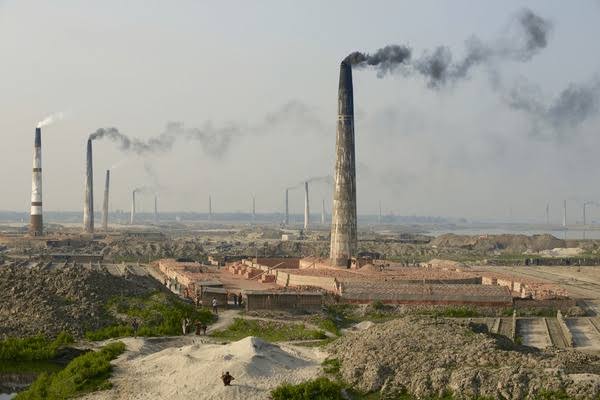Staff Correspondent
Published:2025-08-20 00:30:47 BdST
Illegal brick kilns in Savar, Dhamrai worsen Dhaka’s air pollution
For the first time in the country, the government has declared Savar Upazila a “Degraded Airshed”, marking it as a critical pollution zone.
While clean air should ideally contain no more than 5 micrograms of pollutants per cubic metre for safe human intake, the level in Savar is nearly 20 times higher. Moreover, air pollution in the area exceeds safe limits on more than 160 days each year.
The adjacent Dhamrai Upazila is also witnessing rising pollution levels. There are 272 illegal brick kilns operating across both upazilas, whose emissions are significantly polluting Dhaka’s air.
This designation was announced via a circular signed by Dr Mohammad Kamruzzaman, Director General of the Department of Environment (DoE) under the Ministry of Environment, Forest and Climate Change, on the night of Sunday, 17 August.
According to Rule 5 of the Air Pollution (Control) Rules, 2022, the government has designated Savar as a Degraded Airshed. From September, all types of brick kilns—except tunnel and hybrid Hoffman kilns—will be prohibited from operating in Savar. This will result in the shutdown of 107 brick kilns. Additionally, open burning of solid waste has also been banned in the area.
Industrial or infrastructural projects with a potential to cause air pollution will no longer be granted location or environmental clearance. More stringent measures are expected in the near future under a newly proposed action plan. The directive has been ordered into immediate effect in the public interest.
As per DoE standards, ambient air pollution in Bangladesh should not exceed 35 micrograms per cubic metre annually. However, the World Health Organization (WHO) recommends a much stricter limit of just 5 micrograms. Data from continuous air quality monitoring stations indicate that pollution levels in Savar currently exceed WHO standards by 20 times, and are nearly three times higher than the national standard.
Daily air quality standards also differ. The maximum acceptable daily pollution level is 65 micrograms per cubic metre, yet in 2023, this threshold was exceeded on 164 days. In 2024, it has already been surpassed on over 160 days.
One of the major components of air pollution is black carbon, or “black smoke”. In Dhaka, black carbon concentration ranges between 6 and 8 micrograms per cubic metre—whereas in developed cities, the range is merely 0.5 to 0.8. This indicates that Dhaka’s air contains 7 to 11 times more black carbon. Brick kilns are the primary culprits behind these emissions.
Public health experts warn that such high levels of pollution are causing serious harm to human health. Black carbon not only degrades the environment and accelerates climate change, but also enters the bloodstream through inhalation, contaminating it and triggering various diseases. It is leading to preventable deaths and increasing healthcare costs.
Md Ziaul Haque, Director of Air Quality Management at the Department of Environment, said, “Considering the health of the public, we have declared Savar a Degraded Airshed. The Bangladesh Brick Manufacturers and Owners Association has supported this decision. According to national standards, Savar’s air is three times more polluted, and according to international standards, it is 20 times worse. This step will significantly reduce air pollution in both Savar and Dhaka, safeguarding public health.”
When asked how air from Savar and Dhamrai affects the residents of Dhaka, he explained that during the dry season—approximately five months each year—wind flows from the northwest and northeast toward the southeast and southwest, bringing polluted air from Savar into Dhaka. As a result, pollution levels in various areas of the capital rise sharply, exposing the densely populated city to severe health risks.
Global rankings place Bangladesh at the top of the world’s most polluted countries. The average PM2.5 pollution level in the country fluctuates around 100 micrograms. Bangladesh has consistently held the position of the most polluted country in the world. No other nation comes close in terms of pollution levels, according to Swiss-based global air quality monitoring platform IQAir.
Their live reports on nearly 100 major cities show Dhaka’s Air Quality Index (AQI) often ranges between 300 and 400. Bangladesh regularly tops the list of the world’s most polluted cities.
According to AQI standards: 0–50 is considered good, 201–300 is very unhealthy, 301–500 is hazardous, often prompting red alerts.
Professor Ahmad Kamruzzaman Majumder, Chair of the Centre for Atmospheric Pollution Studies (CAPS) at Stamford University, said that Savar, as well as Gazipur and Narayanganj, significantly contribute to air pollution in Dhaka. While the circular's restrictions technically apply to all regions, implementation remains a major challenge.
Nevertheless, he welcomed the initiative to treat Savar as a pilot area for enforcement.
Unauthorized use or reproduction of The Finance Today content for commercial purposes is strictly prohibited.


